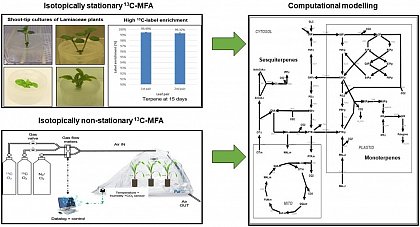Terpene Biosynthesis
Dr. Manish Raorane
Plants synthesize mono- (C10) and sesquiterpenes (C15) as defense against herbivores. These compounds are also the main constituents of essentials oils and therefore of pharmaceutical interest. According to literature, sesqui- and monoterpenes are exclusively synthesized via the cytosolic mevalonate and plastidic non-mevalonate pathway, respectively. However, there is growing evidence that both pathways might actually contribute to both terpene groups. We want to quantify these contributions in different plant species with two different metabolic flux analysis (MFA) approaches.
In the first approach. We use shoot cultures of mint and other members of the Lamiaceae family growing on 13C-labeled sugars as a model system for sink leaf metabolism. Intermediates and end products of central metabolism and terpene biosynthesis are measured by GC- and LC-MS/MS. We then use the data in computational models to calculate intracellular fluxes by steady-state MFA. Using this technology, we can quantify the percentage contribution of each of the two pathways to different terpene groups.
In the second approach, maize seedlings with induced terpene biosynthesis are supplied with 13CO2 in a labeling chamber that was specifically designed for this project. Metabolites are in steady-state, but the label is followed through metabolism in a dynamic manner. The subsequent instationary MFA is computationally more demanding than steady-state MFA.

